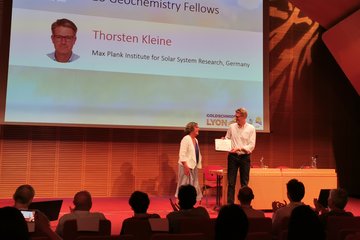Alle Typen
121.
Zeitschriftenartikel
Properties of quiet-sun coronal plasmas at distances of 1.03 lt;= RS lt;= 1.50 along the solar equatorial plane. Astrophysical Journal 518, S. 500 - 507 (1999)
122.
Zeitschriftenartikel
Outflow Velocities at the Base of a Polar Coronal Hole during the 1998 Total Eclipse. Space Science Reviews 87, S. 291 - 294 (1999)
123.
Zeitschriftenartikel
Intercalibration of SUMER and CDS on SOHO. I. SUMER detector A and CDS NIS. Applied Optics 38, S. 7035 - 7046 (1999)
124.
Zeitschriftenartikel
Signatures of coronal hole spectra between 660 and 1460 Å measured with SUMER on SOHO. Space Science Reviews 87, S. 299 - 302 (1999)
125.
Zeitschriftenartikel
Coronal Holes Properties Observed with SUMER. Space Science Reviews 87, S. 315 - 318 (1999)
126.
Zeitschriftenartikel
Coronal holes versus normal quiet Sun observed with SUMER. Astrophysics and Space Science 264, S. 53 - 61 (1999)
127.
Zeitschriftenartikel
Solar irradiances of UV and EUV lines during the minimum of the sunspot activity in 1996. Advances in Space Research 24, S. 229 - 232 (1999)
128.
Zeitschriftenartikel
The solar ultraviolet spectrum from 1200 Å to 1560 Å: A radiometric comparison between SUMER/SOHO and SOLSTICE/UARS. Astronomy and Astrophysics 352, S. 321 - 326 (1999)
129.
Zeitschriftenartikel
SUMER measurements of nonthermal motions: Constraints on coronal heating mechanisms. Astrophysical Journal 505, S. 957 - 973 (1998)
130.
Zeitschriftenartikel
Photospheric magnetic field changes associated with transition region explosive events. Astrophysical Journal 497, S. L109 - L112 (1998)
131.
Zeitschriftenartikel
Chromospheric upflow events associated with transition region explosive events. Astrophysical Journal 504, S. L123 - L126 (1998)
132.
Zeitschriftenartikel
The electron pressure in the solar lower transition region determined from O V and Si III density-sensitive line ratios. Astrophysical Journal 507, S. 991 - 996 (1998)
133.
Zeitschriftenartikel
The Si/Ne abundance ratio in polar coronal hole and quiet-Sun coronal regions. Astrophysical Journal 504, S. 573 - 587 (1998)
134.
Zeitschriftenartikel
High-temperature lines in SUMER spectra recorded above a bright solar active region. Astrophysical Journal 503, S. 467 - 474 (1998)
135.
Zeitschriftenartikel
The coronal composition above the solar equator and the north pole as determined from spectra acquired by the SUMER instrument on SOHO. Astrophysical Journal 505, S. 999 - 1006 (1998)
136.
Zeitschriftenartikel
Solar radiometry with the telescope and vacuum-ultraviolet spectrometer SUMER on the Solar and Heliospheric Observatory (SOHO). Metrologia 35, S. 671 - 675 (1998)
137.
Zeitschriftenartikel
Evidence in support of the ``nanoflare'' picture of coronal heating from SUMER data. Astrophysical Journal 502, S. 981 - 996 (1998)
138.
Zeitschriftenartikel
Solar H I Lyman α full disk profile obtained with the SUMER/SOHO spectrometer. Astronomy and Astrophysics 334, S. 1095 - 1098 (1998)
139.
Zeitschriftenartikel
Observations of the solar atmosphere from the Solar and Heliospheric Observatory (SOHO). Journal of X-Ray Science and Technology 7, S. 249 - 255 (1998)
140.
Zeitschriftenartikel
Radiometric calibration tracking of the vacuum-ultraviolet spectrometer SUMER during the first year of the SOHO mission. Applied Optics 37, S. 2646 - 2652 (1998)











